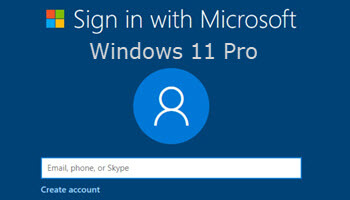Many of you would probably be aware that, since the very beginning, a Microsoft account has been required to install Windows 11 Home. Now, with its latest Windows 11 Insider Preview build 22557 (on the Dev channel) Microsoft has applied the same requirement for Windows 11 Pro. Once this build is released for general use, users who buy a new PC, and go through the OOBE (out-of-box-experience), will need to sign in to a Microsoft account to set up Windows 11 Pro. The same applies for a clean install — it will also require a Microsoft account.
Similar to Windows 11 Home edition, Windows 11 Pro edition now requires internet connectivity during the initial device setup (OOBE) only. If you choose to setup device for personal use, MSA will be required for setup as well ~ source
As you can imagine, this news has not gone down well with some users but, while I can understand the frustration of yet another seemingly dictatorial decision by Microsoft, I really see no harm. Signing in with a Microsoft account does provide a number of benefits — it allows users to sync personalization settings across multiple devices, for example. A Microsoft account also allows seamless access to the Microsoft Store, as well as tying the digital license to the user’s account — which can be convenient following a fresh install. I have always set up all my PCs with a Microsoft account.
Furthermore, Apple has always required an account for its devices, the same as Google requires an account for Android devices. So, I see this move by Microsoft as more getting into step with other platforms rather than any sinister intentions. When you think about it, just about everything we do online nowadays requires an account- shopping, accessing online services, even something as simple as posting on a forum often requires creating an account. It’s the main reason password managers are so popular, we all have multiple accounts, so many that keeping track of them all with no assistance from a dedicated program would be nigh on impossible.
BOTTOM LINE:
As I said, I can certainly understand the annoyance from users who perceive this as a dictatorial decision by Microsoft, taking away yet another option from the user. However, in today’s climate, the decision makes perfect sense to me.
Let us know your thoughts via the comments.
- NOTE: At the time of writing this article it is not clear if the user will be able to revert to a local account once the operating system has been fully installed. I guess only time will tell.
—


I question how that is going to work out for them as I just had to go BACK to Win 10 from 11. The reason I have the question is that when I tried to roll back the proper way through windows updates, it crashed, and the only way I was able to resolve it was that I have made a cloned drive of my Win 10 from which I was able to restore my main drive from. Not that this can’t be resolved, it would potentially cause M$ some obvious problems in sinking who has what when.
The issue as I see it is that so many people have Gmail (Google) accounts, while so many people have Windows (Microsoft) computers. For people who don’t want multiple accounts, its a bit awkward being forced to create a dedicated Microsoft account when you live your whole online existence in the Google atmosphere.
Some past editions of Windows “required” a Microsoft account, but it was possible to find a way around it. I guess the noose is being tightened so that there’s no way of escaping.
Hey Tony,
There are still ways to get around this and install Windows 10 Home and Pro without requiring a Microsoft account or interment connection. There are plenty of guides online if you search around.